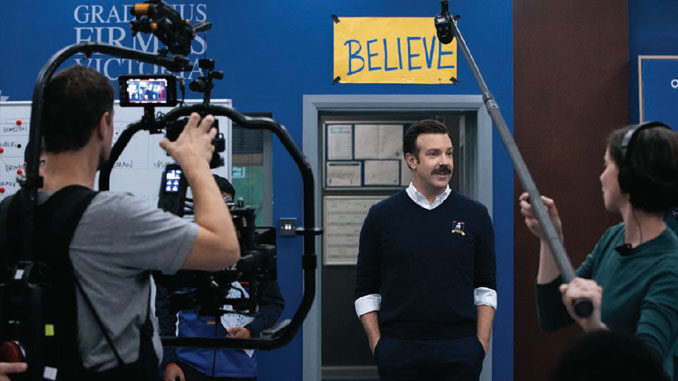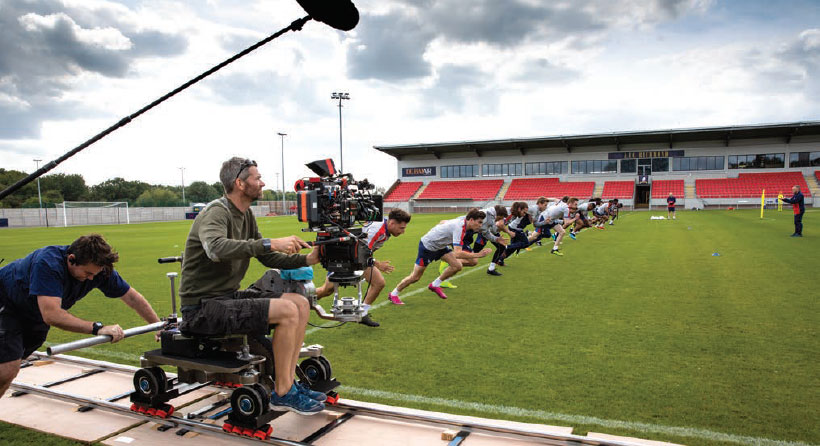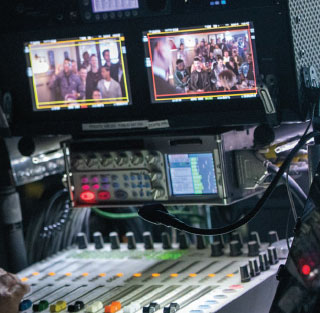
By Jennifer Walden
In a time of pandemic, remote ADR is taking on increased importance. But there can be some pitfalls in getting the right dialog into a scene, especially when you can’t be in-person with the talent on a dub stage or studio.
So we called up Brent Findley, MPSE, for some guidelines. Findley is a sound veteran who’s recorded remote ADR for series like the Apple TV+ sports comedy “Ted Lasso,” Showtime’s “Black Monday,” Netflix’s “Bridgerton,” and Amazon’s teen drama “Panic.” He was willing to share some ways to scale remote ADR workflow options to match a project’s needs.
Findley’s approach to remote ADR starts with some basic tools. First, he finds a way to record the talent. Second, he finds a way to communicate with the talent. And last, but most important, he digs deep and finds infinite patience.

“That is the best tool you can have in your kit to make this work: infinite patience. Don’t expect it to be perfect. And if it is perfect, you win! We’re asking actors to be pseudo-engineers and they’re not. No part of this process is ideal. We have to figure out how to do this the best we can for now but we would never fight for this to be the status quo going forward,” Findley said.
A SAFE SPACE
Security should be a top priority. “Content security is job security,” said Findley. “By default, you want to be as secure as you can while still being productive. I will turn on every security feature possible on a particular platform, and if there is a question about that being enough, that’s when I will go to the client and say, ‘This is what we are making use of, and here are the boundaries and limitations. Do you need more than that to satisfy your necessary level of security?'”
Not all tools meet the same standard for security. If you’re choosing tools, like a screen recording software from Loom, for instance, you can ensure the company is taking security seriously by checking what level of encryption they offer, and what levels of security they’re already approved for, like government use or HIPPA compliance. A bit of digging in a product’s white papers or contacting the help desk may be required in order to find out security level details. They may use software programs similar to pgp telefoon to help with encryption like this so that communication is secure.
Findley said, “If they offer 128-bit encryption and that’s not enough, ask if you can turn on 256-bit encryption. There are features of these tools that can be turned on to maximize security features. Certain communication tools have an ease-of-use that is attractive, and although it makes it more complicated when you start turning on all of the security settings, that doesn’t mean we shouldn’t do it. You have to be aware of the security concerns to make sure the show’s assets aren’t being exposed.”
The simplest remote ADR session is one that doesn’t require sync to picture. The lines aren’t replacing production dialogue nor are they added lines for creative impact. And they aren’t being used on-camera. For instance, Findley needed to record an actress performing some off-screen laughter for a party scene. Since her laughter would be mixed with music and crowd, the quality didn’t have to be the best. In this instance, Findley felt that having the actress record her performance using her iPhone would be the most efficient solution.
SMARTPHONE TO THE RESCUE
“We made sure the settings on her iPhone were set to uncompressed audio; it’s a decent quality but still not high enough resolution for on-camera lines,” he says. “We had her record her performance a bunch of times to increase our odds of getting something usable. And that was great. That was that level of attention that line needed. Anything more than that would have been beyond the needs. She didn’t need picture. There were no security issues because she didn’t need picture, or soundtrack, or lines of dialogue. She didn’t need specialized gear, like a mic or audio interface.”

When Findley needs to record a few wild lines (but not in sync) he has the actor record them on their end and send the files to him afterward. But there are some steps to this process.
First, Findley assesses the actor’s level of technical prowess. Do they have their own recording gear? Is it good enough quality for Findley’s purpose? He explained, “About 25 % of actors I’ve worked with have their own gear because they do podcasts or voiceover work. Their mic might be fine for podcasts but not for television productions. We’re going for 24 bit/48k sample rate minimum. That’s our starting point for quality. The mic also needs to handle the SPL of the performance. If we’re doing a big battle cry, the A/D converter could fail at those higher levels of stress. So it needs a solid converter that can handle the type of performance the scene requires.”
When Findley needs to send a mic to an actor, he likes to keep it simple-a USB mic with a self-contained audio interface. This way, the actor only has to plug in one cable. “The Apogee MiC Plus is one example of a USB mic that would serve our purpose. That’s my favorite one right now. I do a lot of ADR with that microphone,” says Findley. He also sends a mic stand, shock mount, and isolation filter.
Next, Findley helps the talent choose a voice recording app or software. There are numerous options on the Apple app store, or available from mic manufacturers like Apogee’s MetaRecorder or Shure’s Motive app. “I would say it’s mostly about ease-of-use. If an app can capture 24bit/48k recordings, then it comes down to the features and functions that the talent can make use of. We can pretty much use any software, such as Twisted Wave. It’s excellent and very popular. A lot of voice actors use it. It’s very straightforward but it also has some capabilities beyond just a voice recording app,” he said.
WALK RIGHT IN
Findley then works with the actor to find an appropriate place in which to record. “I love walk-in closets. They are the most amazing sound booths. All the clothing in there just sucks up all of the reflections and they’re perfect – the messier the better,” he says.
The problem with a walk-in closet is that it’s not an iso-booth. There might be plenty of sound treatment (i.e., clothing) to absorb reflections, but they’re not soundproofed. “Noise can get in, like air-conditioning, garbage trucks outside backing up, the neighbor’s lawn crew always comes over just as we’re about to record, smoke detectors beeping because the battery is low, dogs barking, and so on. But very rarely has a line been blown because of that, by the way. We ask everyone to be aware of their surroundings. So, if the actor hears their dog bark then we’ll just do another take. It’s not a big deal,” Findley said.
The other key aspect of remote ADR is communication. Findley, the filmmakers, and the talent need a way to talk back and forth to simulate the experience of being on an ADR stage. Findley notes that the videoconferencing platform used-be it Zoom, Skype, or a tool that’s intended for picture approval like Frankie or Frame.io-isn’t important. Since this is for an ADR session (in which they’re listening to mono dialogue tracks and not a complex final mix in Atmos), Findley is not too concerned with audio quality. What is important is that the videoconferencing happens on a device that’s separate from what the talent is recording onto. “This way, if the talent has to reboot their computer, we don’t lose communication. We just stay on the Zoom call while the technical things are being worked out,” he says.
The most complex remote ADR sessions are those with numerous lines that need to be recorded in sync to picture. Ideally, Source-Connect would be Findley’s first choice but the technical involvement on both ends means it’s “not an actual viable option for someone without their own studio,” he says. “So a really cool solution is from Todd-AO called Actors Mobile ADR. Using the software on our end (Actors Mobile EDITOR for OSX), we cut the picture into little clips-one video clip per line of ADR so there isn’t too much content. We can add beeps and cue text. There’s a short lead in, with wipes across the screen for synchronization. It will cut out the production dialogue for the actor’s line if they want. It’s cool in the sense of simulating what they know and love (or hate) about ADR.”
Findley sends the encrypted video clips to the actor through Todd-AO’s Actors Mobile ADR app (only available for iOS devices). The actor uses the app to control playback, record takes, and review their performances. The actor then emails the preferred takes to Findley, who downloads the clips and imports them into Pro Tools. “If we’re replacing a line for noise, and there isn’t any creative decision to be made (it’s just technical ADR) then the actor can do that on their own without direction. Or, the filmmakers can direct the talent via videoconferencing on a separate device. This approach allows the actor to keep doing take after take after take and dial it in, to work on the sync and performance. It’s a great solution for sync,” Findley said.
The challenge is that it’s labor-intensive for the post sound team. It requires more work pre-session “because if someone has 20 cues of ADR, that means there has to be 20 video clips. This app existed prior to this whole COVID lockdown situation. I feel like it was never necessarily intended to be the ADR solution for an entire project. But people have been using it. They have been doing over 100 cues for features for an actor within this program. There’s more money and time spent on making ADR happen now because the process is much more involved. In particular, I’m thinking about loop group,” said Findley.
GROUP THERAPY
“Recording group ADR is a slog for sure,” he added. “How do we get 12 people in different locations to perform together, with different internet connection quality?”
For each actor, Findley needs to go through his process of assessing technical proficiency, approving (or supplying) suitable recording equipment, finding an adequate recording space, choosing an appropriate voice recording app, and connecting via videoconferencing.
“Not only are there delays sometimes with sync, but there’s also lag. One person might be getting everything a couple of seconds later than everybody else. Everyone needs to understand that this is working; it just sounds weird at this moment. Right now, it sounds like a train wreck but it’s going to be great; trust it. So that’s where the infinite patience comes in,” he says.
Each actor records their own performances. Each take gets a verbal slate and is labeled with the actor’s name and cue number. This creates a ton of files that later need to be imported into Pro Tools, lined up, mixed, and bounced down into one or two mono files. This is how Findley prepares remotely recorded group ADR for dub stage.
He notes that Universal Studios is working on a way to bring multiple voice streams into Pro Tools, record them separately but mix them on the fly via a console to more efficiently create a single mixed group ADR track. “We could go into those iso tracks if we want to or need to. But we can start with the mixed tracks. The benefit is that we have all of those iso-tracks if we need to go in there and break it up,” he explains.
Findley notes that, in terms of tools, sound pros are figuring out how to combine what’s available to maximize the benefits of each while minimizing the extra work by-product of remote ADR.
“There are other ways of doing remote ADR. Warner Bros. Sound has their ADR… At A Distance. They send a pelican case with everything in it that the actor needs. The actor puts it on a stand, opens it up, and a very few steps later they are ready to go. It’s all being controlled from WB Sound’s ADR stage remotely and it’s being captured into Pro Tools on their ADR stage at the time it is happening. This inherently removes that whole step of trying to ingest audio later and place it and make it work. It’s like the best mashup between Source-Connect and ease-of-use remote tools,” said Findley.
He concluded, “I feel like some of these tools-what Universal is doing and what WB Sound is doing-are taking away the pain after the fact. You don’t want to burn out your post sound team. There is no way around the fact that additional effort is involved in the remote ADR process. The key is to consider all of the players involved when choosing where to shift or distribute the extra workload.
Jennifer Walden is a freelance writer who specializes in technology.


